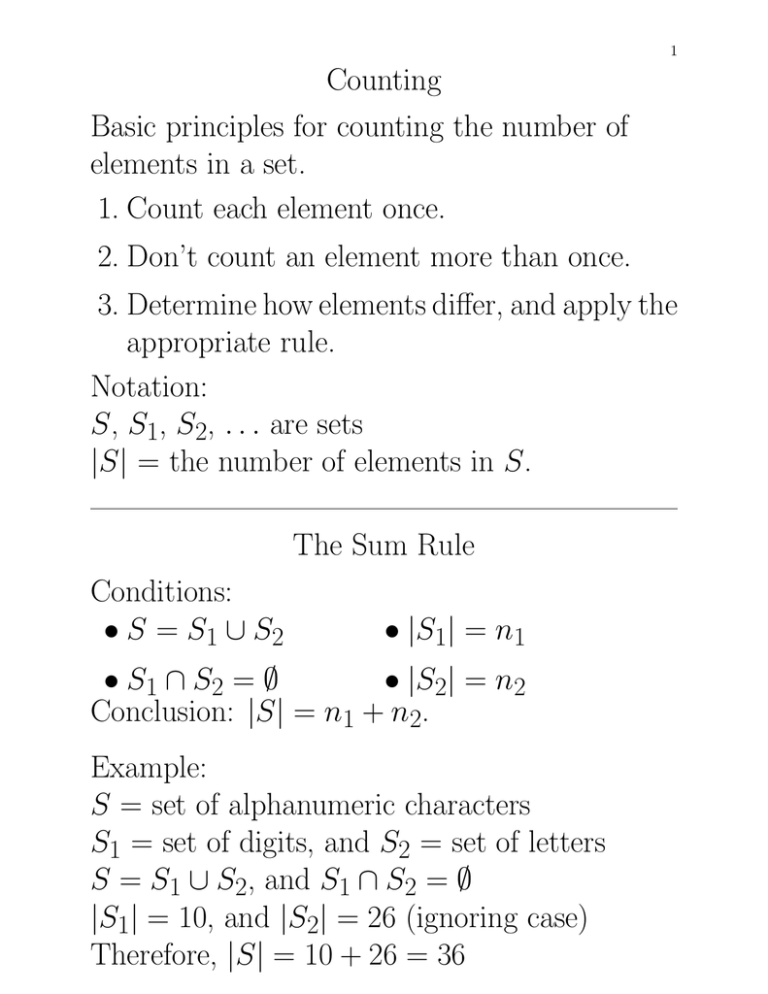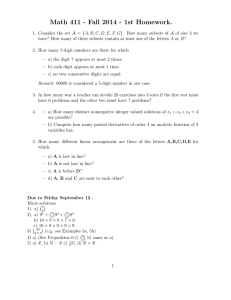Counting Basic principles for counting the number of elements in a
advertisement

1
Counting
Basic principles for counting the number of
elements in a set.
1. Count each element once.
2. Don’t count an element more than once.
3. Determine how elements differ, and apply the
appropriate rule.
Notation:
S, S1, S2, . . . are sets
|S| = the number of elements in S.
The Sum Rule
Conditions:
• S = S1 ∪ S2
• |S1| = n1
• S1 ∩ S2 = ∅
• |S2| = n2
Conclusion: |S| = n1 + n2.
Example:
S = set of alphanumeric characters
S1 = set of digits, and S2 = set of letters
S = S1 ∪ S2, and S1 ∩ S2 = ∅
|S1| = 10, and |S2| = 26 (ignoring case)
Therefore, |S| = 10 + 26 = 36
2
The Product Rule
Conditions:
• S = S1 × S2
Conclusion: |S| = n1 ∗ n2.
• |S1| = n1
• |S2| = n2
Example:
S = two digit numbers, no leading zeroes
S1 = {1, 2, 3, 4, 5, 6, 7, 8, 9}
S2 = {0, 1, 2, 3, 4, 5, 6, 7, 8, 9}
|S1| = 9 and |S2| = 10
Therefore, |S| = 9 ∗ 10 = 90
The Inclusion-Exclusion Principle
Conditions:
• S = S1 ∪ S2
• |S1| = n1
• |S1 ∩ S2| = m
• |S2| = n2
Conclusion: |S| = n1 + n2 − m.
Example:
S = 2-digit numbers with a 9, no leading 0’s
S1 = two digit numbers beginning with 9
S2 = two digit numbers ending with 9
S = S1 ∪S2, |S1 ∩S2| = 1, |S1| = 10, and |S2| = 9
Therefore, |S| = 10 + 9 − 1 = 18
3
Generalizations
Generalized Sum Rule:
• S = S1 ∪ S2 ∪ . . . ∪ Sk
• if i 6= j, then Si ∩ Sj = ∅
• |S1| = n1, |S2| = n2, . . . , |Sk | = nk
k
Conclusion: |S| = Σ ni
i=1
Generalized Product Rule:
• S = S1 × S2 × . . . × Sk
• |S1| = n1, |S2| = n2, . . . , |Sk | = nk
k
Conclusion: |S| = Π ni
i=1
Problem structure:
Many problems require multiple rules.
How many strings of letters of length 4 or less?
4
The Pigeonhole Principle
Conditions:
• S = S1 ∪ S2 ∪ . . . ∪ Sk
• |S| = N
Conclusion:
At least one subset has at least dN/ke elements.
Example 1:
Out of 50 people, how many were born in the
same month?
S = 50 with 12 subsets
At least one month has at least d50/12e = 5
people born in that month.
Example 2:
A drawer contains black, brown, and white socks.
How many socks ensure two of the same color?
There are 3 subsets: black, brown, and white.
Want one subset with at least 2 elements.
Need to find N so that dN/3e = 2.


